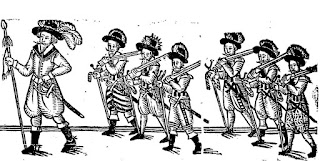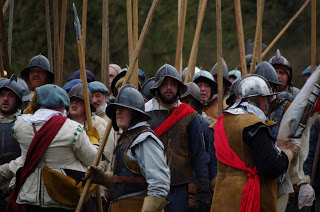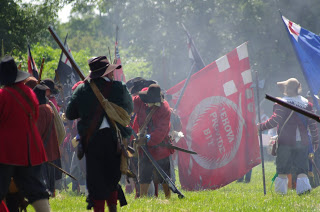Coat Colours
This post now serves as a preface to my coat colours posts (links below), and provides some background information on who was issued clothing, what constituted a 'uniform', and hopefully dispels some of the Wargamer Facts™ that surround 'Civil War uniformology'.
The fanciful Victorian imagery of the Wars has pretty much been dispelled* (Roundheads in striped sleeved shirts, Cavaliers in poncey big hats); in reality both sides were, very much of a muchness. There are some items of equipment and uniforms, still in existence, that give us a starting point. Our best primary source of evidence are contemporary eye witness accounts, from spies to flag designers, account books from great houses and military manuals.
Whilst I do strive for accuracy, at the end of the day my armies are a pastiche, they aim to give a 'feel' rather than pleasing the 'button counters' that populate the darker corners of the wargaming community. But, as there is so much that historians don't know about Civil War 'uniforms', a pastiche is probably the best that anyone can aspire to.
>>>>
Whatever you do, avoid asking the questions such as 'what colour did Parliamentarians wear?' on wargames forums. You will be inundated by a plethora of Wargamer Facts™... Royalists wore red, nobody had uniforms until the New Model Army, dyes weren't very good, nobody had a uniform etc etc ad infinitum. Whilst these Wargamer Facts™ have a soupcon of fact behind them, they have been twisted and tortured into pure nonsense.
Let's look at these Wargamer Facts™ in detail: neither side favoured a particular colour. Both sides wore red, and blue, and grey. It does appear that soldiers raised and equipped in certain areas, regardless of loyalty, do tend to wear the same colours of coats. We do see certain colours of coats being issued across the board - red, blue, grey and white (in other words undyed wool) - these were the cheapest colours to produce. Green, purple, yellow, and in particular black, were very expensive and difficult to produce.
Nobody wore uniforms, they should all be in civilian clothes: the use of the term 'uniform' is problematical, as we immediately think of lines of identically dressed soldiers. Soldiers during the Civil Wars were given clothing, some of the time they were given the same coloured clothing as their comrades in the same unit. Replacing the word 'uniform' with 'clothing' is helpful in differentiating between what we think of as uniforms and what was issued to the rank and file in the C17th.
Trained Band soldiers would, in theory be wearing their own clothes (all to do with how Trained Bands were formed, and who was eligible/required to be a member of the local Trained Bands), Auxiliary (sometimes called volunteers) units of the Trained Bands are more likely to have been issued clothing.
Many believe, and argue, that there were no uniformly coloured coats issued to soldiers prior to the advent of the New Model Army; we know of coloured coats being issued to about sixty Parliamentarian regiments of foot prior to the formation of the NMA, and about 45 Royalist regiments of foot. There are many more that we know of, who were issued clothing, but not what colours these garments were. These known coat colours were predominantly within the great field armies that campaigned year round. It appears that these men were issued new clothing about every twelve months.
With the knowledge that the various field armies re-clothed their men at approximately twelve month intervals it is fairly safe to assume that coat colour references are good for about a year from date of issue. The field armies re-equipped their men in what was available, so you may find one regiment with several different known coat colours during their existence.
Of course that doesn't mean that soldiers didn't wear civilian clothes; it is inevitable that clothing wore out and individuals would replace it with whatever they could buy, beg, steal or borrow. It is also highly likely that units raised for short periods of time, say to defend a city under siege, would be less likely to have had standardised clothing issued.
C17th observers recorded what they believed to be important, their notion of important is different to what we now think of as important. We want to know coat colours, but as regiments might be issued different coloured coats every twelve months or so, their flags would usually stay the same, so contemporary observers wrote of 'green regiments' - referring to flag colours rather than coat colours.
Dyers were a guilded profession, and whilst C17th dyes were not as bright as their C21st equivalents, dyers were very proficient and competent workers. Their dyes were colourfast, they knew how to fix dyes; but it is inevitable that over a year of campaigning colours would inevitably fade. Dye batches might have a slight variation, and it is highly likely that felted dyed fabric was utilised from a number of dyers to fulfill an order. One London supplier was able to turn around an order for 500 coats for the NMA in just two weeks. As large scale factory production didn't exist he must have outsourced batches to a number of smaller dyers, and tailors.
Other Wargamer Facts™ nonsense that you will hear...
The regiments that fought in Ireland all wore yellow coats (or red coats, or green coats depending upon who answers you). There is a mix of recorded coat colours for those regiments that served in Ireland .
The Irish wore green... another gem that has more to do with the tourist shop at Dublin Airport than anything resembling historical fact.
Illustrations in Haythornthwaite and the Osprey series are definitive, apparently; colours randomly picked by the artists are now definitive, rather than having been picked for their artistic merit.
Grey coats means white coats (and vice versa) this one is a little more problematical to 'deal with'. Both refer to undyed wool coats. Yorkshire sheep farmer Henry Best tells of keeping three or four black sheep in a flock in order to produce grey cloth for stockings, but warns that too many black sheep makes the cloth 'hairy (and) scarce vendible'. (Rural Economy in Yorkshire 1641: Being the Farming and Account Books of Henry Best, of Elmswell, in the |East Riding of the County of Yorkshire)
The fact that newsbook writers refer to 'white' and 'grey' must surely mean that there were two mixes of wool - a mix of white sheeps' wool, and a mix of white sheeps wool with a handful of black sheeps' wool mixed in.
Different regions had common colours of coats. This one is actually fairly accurate. We know that soldiers from Essex were equipped with red coats lined blue, and those from Surrey and Sussex were given red coats lined orange. Several regiments in Newcastles' Army are described as lambs, or reported as wearing white coats.
The latest has come from the use of contrast/speed paints; a particular bright blue shade is becoming a Wargamer Fact™ historically accurate, definitive colour because it was used in a 'how to paint Epic Pike and Shotte video', again ignoring the fact that the painter picked it on artistic merit (from a limited colour palette) rather than any nod to a historical dye colour.
>>>>
My unit choices are based upon coat colours (or civilian clothes in the case of the Trained Bands) that are known with standards that are known or we can have a very good stab at. Consider it a fantasy football league approach to army building. These were my methods for choosing regiments to represent, rather than the order of battle at Marston Moor say. On the odd occasions where I represent unknown coat colours or flags I look at the Colonel's coat of arms, and other regiments from the same locality for colour inspiration.
My unit choices are based upon coat colours (or civilian clothes in the case of the Trained Bands) that are known with standards that are known or we can have a very good stab at. Consider it a fantasy football league approach to army building. These were my methods for choosing regiments to represent, rather than the order of battle at Marston Moor say. On the odd occasions where I represent unknown coat colours or flags I look at the Colonel's coat of arms, and other regiments from the same locality for colour inspiration.
>>>>
Where to find out coat colours?
Where to find out coat colours?
My first stop used to be the BCW Regimental Wiki part of the rather good BCW Project, a rather expansive on-line resource documenting the British Civil Wars. The regimental wiki lists regiments by allegiance, and also by which phase of the wars. It provides any known battle participation, historical references, coat colours and standards (along with primary source references), and links to any re-enactment groups. Now, I tend to rely upon my own coat colour lists and research (links below).
May 2025 update: BCW Project and Regimental Wiki are back!
Both the Sealed Knot and ECWS sites, and their individual regimental websites (and Facebook pages) are fantastically inspiring in getting a visual idea of a 'look' to aim for. I post photos from Sealed Knot and ECWS events that I have attended - have a look at posts labelled painting guide for some inspiration.
Historical references and wargaming painting guides will often just mention a colour, for example 'red'; but as we know 'red' comes in all manner of shades and hues. Throw in the mix dyes which were unstable, and we have carte blanche for artistic freedom. To help with a colour palette you might find this useful.
Regiments often changed their names, taking on the name of their Commanding Officer at the time; if you have found a commercially available flag that you want to use but can't find the Regiment in the Wiki, search the Wiki for the name that you 'know'. You may well find that the regiment you were looking for has many different names.
Another consideration I had was for the overall look of each army. Too many red coated units? Maybe needs a white coat or green coated unit for a bit of variety...
From the slightly skewed wargamer angle of 'what colour coat and do we know about their flag' the BCW Regimental Wiki can be a bit laborious to use (searching for a Royalist purple coated unit with flag? You're going to have to check out every regiment until you find one. Spoiler - you won't!).
Slightly irked by seeing the same errors replicated in 'lists of coat colours for wargamers' I decided to write my own: my lists only include those regiments with contemporaneous references, or those where the weight of evidence is very suggestive of a coat colour. In all cases I have provided the appropriate reference.
Both the Sealed Knot and ECWS sites, and their individual regimental websites (and Facebook pages) are fantastically inspiring in getting a visual idea of a 'look' to aim for. I post photos from Sealed Knot and ECWS events that I have attended - have a look at posts labelled painting guide for some inspiration.
Historical references and wargaming painting guides will often just mention a colour, for example 'red'; but as we know 'red' comes in all manner of shades and hues. Throw in the mix dyes which were unstable, and we have carte blanche for artistic freedom. To help with a colour palette you might find this useful.
Regiments often changed their names, taking on the name of their Commanding Officer at the time; if you have found a commercially available flag that you want to use but can't find the Regiment in the Wiki, search the Wiki for the name that you 'know'. You may well find that the regiment you were looking for has many different names.
Another consideration I had was for the overall look of each army. Too many red coated units? Maybe needs a white coat or green coated unit for a bit of variety...
From the slightly skewed wargamer angle of 'what colour coat and do we know about their flag' the BCW Regimental Wiki can be a bit laborious to use (searching for a Royalist purple coated unit with flag? You're going to have to check out every regiment until you find one. Spoiler - you won't!).
Slightly irked by seeing the same errors replicated in 'lists of coat colours for wargamers' I decided to write my own: my lists only include those regiments with contemporaneous references, or those where the weight of evidence is very suggestive of a coat colour. In all cases I have provided the appropriate reference.
A number of coat colour lists, both in books and on the internet, will prescribe colours to regiments not included in my coat colours lists: some of these coat colours stem from the outdated belief that a reference to a 'yellow regiment' referred to their coat colour - it doesn't, it refers to the colour of their flag; historically some coat colours have been linked to regiments because of their Colonel's names - Blackwell's must have worn black for example; others have been prescribed because somebody picked a colour at random, others followed suit, and several years down the line you'll find it argued that Sandford's Firelocks definitely wore green coats, when in fact the illustrator for The Osprey Elite, "Soldiers of the English Civil War (1), Infantry" just so happened to use green in his illustration. For all these regiments there is no currently known contemporaneous evidence to support these coat colours.
Evidence keeps being unearthed on a regular basis, since I first wrote my lists, a number of 'new' coat colour references have been discovered. Contemporaneous records keep being discovered in strange places - one only has to think of the copy of the 1300 Exemplification of Magna Carta found in a Victorian scrapbook in 2015. There is a set of records at the The National Records office which all have the catalogue prefix SP28, this vast collection of documents provides many of our known coat colours references. Much of this collection is still to be properly researched... maybe one day it will be digitised!
Other lists exist on the web (these lists, with the exception of the Baccus list, contain many errors, and none of the lists provide sources for colours claimed - think! before getting your brushes wet):
Baccus is one of the better, more accurate, online resources, and has a couple of downloadable *.pdf files which give a handy painting guide, and an introduction to ECW standards. My only criticism is that clothing colours are not referenced.
Wargames Designs are probably best known for their flags they have a list of ECW units by coat colour.
Warlord Games post articles supporting their Pike and Shotte rules, including some basic clothing colour guides and lots of eye candy (albeit in the devil's own 28mm).
* although a brand new 15mm figure range has just been released (October 2023) which uses this long debunked, outdated imagery.
You can find my coat colours articles here:
Part 1 Parliamentarian coat colours
Part 2 Royalist coat colours
Part 3 Scots coat colours
Part 1 Parliamentarian coat colours
Part 2 Royalist coat colours
Part 3 Scots coat colours
Part 3B Montrose and the Irish Brigade
Part 4 Dragoons, Horse and the New Model Army coat colours
The Trained Bands
Part 4 Dragoons, Horse and the New Model Army coat colours
The Trained Bands
Other lists exist on the web (these lists, with the exception of the Baccus list, contain many errors, and none of the lists provide sources for colours claimed - think! before getting your brushes wet):
Baccus is one of the better, more accurate, online resources, and has a couple of downloadable *.pdf files which give a handy painting guide, and an introduction to ECW standards. My only criticism is that clothing colours are not referenced.
Wargames Designs are probably best known for their flags they have a list of ECW units by coat colour.
Warlord Games post articles supporting their Pike and Shotte rules, including some basic clothing colour guides and lots of eye candy (albeit in the devil's own 28mm).
* although a brand new 15mm figure range has just been released (October 2023) which uses this long debunked, outdated imagery.
If you enjoyed reading this, or any of the other posts, please consider supporting the blog.
Thanks.





.jfif)





Comments
Post a Comment